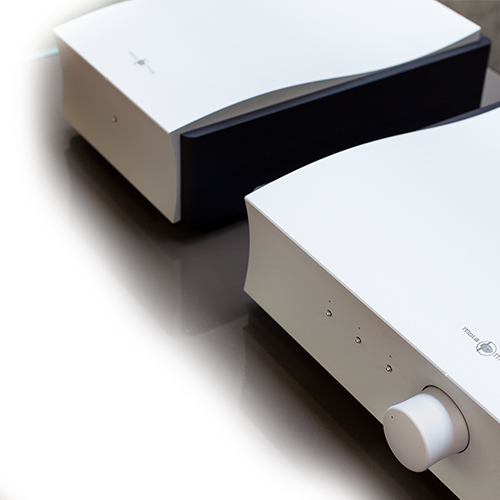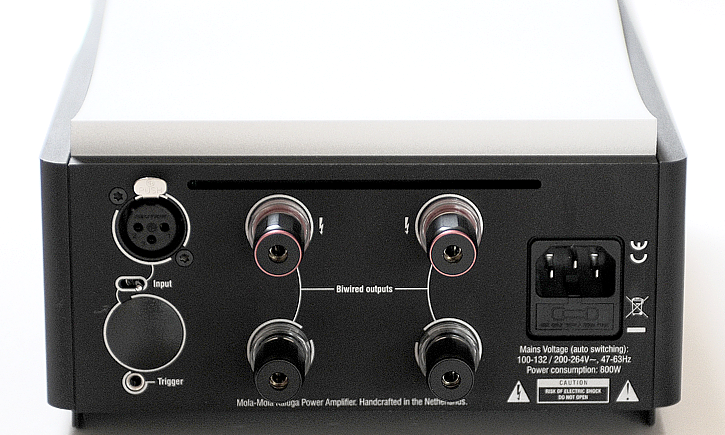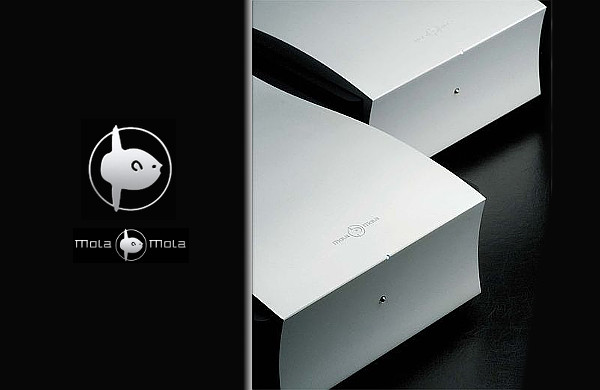MOLA MOLA Kaluga
Power amplifiers
The Kaluga is a switching power amplifier that uses Hypex Ncore modules designed around multiple feedback loops to suppress higher-order harmonic distortion. The feedback loops are applied across the while audioband not to impair spectral balance and to eliminate background noise – the Kaluga represents a really transparent window on recorded music signal.
Funkce a forma
The Mola Mola Kaluga is a beautifully designed pair of Class-D mono amplifiers with a slightly concave faceplate and ocean wave-like on the lid. There is only one control element on the faceplate: a small stainless steel bead that powers the amp on; that is indicated by a tiny LED embedded into the upper faceplate edge. The rear panel hosts RCA and XLR input (one each), a switch to select between inputs, bi-wireable Furutech posts and an IEC input.
The efficiency of the Class-D means that the Kaluga is among the most powerful amps on the market: it delivers 400W into 8 ohms, 700W into 4 ohms and 1200W into 2 ohms, with negligible levels of distortion.
The Kalugas should be ideally completed with Mola Mola Makua preamp, yet I was listening to them separately without the preamp that was not available at the time of the review.
Nízké frekvence
Comparing dub and electronic amalgam of Front Line Assembly (Echogenetic, Mindbase) to Dmitri Shostakovich and Mstislav Rostropivich’s Symphony #11 (LSO, DSD) through the Mola Mola is an interesting exercise. The popular belief goes that dub music digs really deep in bass which is not entirely correct – modern electronic music is usually centered around 40Hz (for weight), around 80Hz (for density of bass) and far above 120Hz for bass’s definition. On the contrary, classical instrumentation reaches down to sub 15Hz territory which is cut off at 20Hz for digital and at around 30Hz for vinyl recordings. Nevertheless the good bass ‘definition’ between 20Hz and 80Hz depends a lot not only on the quality of the audio components but on the room acoustics too. I was lucky to listen to the Mola Mola in acoustically excellent environment and therefore I can say that this amplifier exceeds any expectations.
The bass through the Kaluga is ‘crystal deep’ if I may say. You can almost visualize the waveforms in the room. It is not about usual booming, punching or rumbling – it is as if your whole body was hit by a distant seismic pressure before you hear the sound, followed by the arrival of the sound in such a pristine presentation that one needs to redefine everything about how bass can be reproduced. It is the very combination of the whole body palpitation with the depth of definition that makes the Kaluga’s presentation be heart-stopping. No matter whether I listened to electro-pulses that were punchy and ‘dry’, or tympani rollercoaster of the Symphony #11 that shattered the room, the amplifier was always in utmost control of my speakers and dictated the excursions of Sasha W/P’s dual 200mm polymer woofer cones with a firm grip. The damping factor of 2400 is quite unique in the audio world and the Kaluga keeps it up to 2kHz with a gentle roll-off to 1000 at 20kHz.
The dark side of the Mola Mola Kaluga’s bass? Due to no overhang and smear it sounds different from what we are used to. Thus it actually may sound ‘less developed’ to some ears. The audiophile desire to hear the things ‘as they are recorded’ conflicts with the audiophile desire to hear the things ‘as I like them to hear’. Sorry guys, the Mola Mola Kaluga is the former case.
Čistota rozlišení
After two weeks of listening to music through the Mola Mola you find other electronics to be dirty sounding in comparison. The Kaluga is superbly clean amplifier. There is no music that would not benefit from the uber-resolution of the Kalugas. Kazune Shimizu’s grand piano and Arnhem Philharmonic Orchestra (Tchaikovsky, Piano Concerto #1, Triton) were discerned with a special sense of individualism where all the instruments were superbly isolated in the mix yet glued together in a coherent unity.
Tonální věrnost
With the pair of the Kalugas, tonal fidelity appears to be the most challenging parameter to grasp. They apparently do not add anything to the music, neither does it take away the smallest bit of information. Well-recorded music is incredibly transparent and dynamic through the Mola Mola and appears to be drawn on cosmic vacuum-black background. The specifications show 128dB of S/N ratio which by far exceeds the possibilities of CD, tape and vinyl – to enjoy the Kalugas one has to reach for good DSD recordings. Only if your audio chain is centered around hi-resolution files you’ll be able to exploit the Mola Mola’s potential. And this is the tricky thing: with low res files (aforementioned CD, tape and vinyl) you’ll miss the added beauty and you’ll hate the naked substance of the Kaluga amplification. What does it mean? When I listened to Michael Jackson’s Thriller for instance, the voice was not as expressive, as rich if you want, as with my Spectral amplifier which I consider it to be also a very transparent piece of audio equipment. The same album through my vinyl set-up exposed all the flaws of the media with the Kalugas not adding no euphonic coloration on top of what had been already added by phono stage. This way the timbres sound different that we know them, though they are very accurate, yet they miss a bit more ‘aliveness and light’.
Prostorovost
Spatial presentation of the Kaluga monos is enhanced by excellent separation and focus, and brought down a little by slightly subdued ambience – it is as if some part of the spatiality was encoded in the harmonics that are suppressed by NuCore architecture. I could hear the soft ambient echoes of a cello playing in a church, for example, but the trailing off was unnecessarily fast to my ears. However, the width and depth of the macroimage was excellent and images were locked with surgical precision and authority.
The Mola Mola Kaluga is a very good alternative where a lot of power and control is needed (speakers with a lumpy impedance curve, for example) or where a serious control listening must be accomplished (mixing and control rooms, though they will rather use Grimm Audio active speakers that use the very same NuCore in-built amps). For audiophile listening the Kaluga has both assets and drawbacks that are dictated by our previous experience. It is up to the listener and its ability to abandon listening stereotype in favour of the new – and different - experience.
Připojené komponenty
- Sources: CD/SACD/DVD-A Linn Unidisk 1.1, TW-Acustic Raven One with Graham Phantom tonearm and Transfiguration Orpheus cartridge
- Amplifiers: Spectral DMA-150, phono Gruensch Reference Phonostage MCS
- Interconnects and speaker cables: MIT MA, MIT MA-X XLR, MIT V2.1 Oracle, Stealth Audio Hyperphono
- Loudspeakers: Wilson Audio Sasha W/P, Elac AF 61
- Power conditioning: Furutech Daytona, Oyaide, Nordost Valhalla V2
ACCUPHASE A-300
For Accuphase, the A-300 monoblock amplifier is considered a jewel in the crown. Although it is not the most powerful amp in their line-up – the P-7500 is with its 2x300W in Class AB – it is certainly the most powerful Class A device ...
Doporučení prodejci
Perfect Sound Group, Praha, tel. +420 722 960 690
Nisel SK, Bratislava, tel. +421 905 203 078
ACCUPHASE A-65
The A-65 has a better bottom-end control and though it does not equal to the solidness of, let's say, Bryston or Plinius, the improvement has moved the new amp in the right direction. Overall, the Accuphase A-65 is more refined, ...
Doporučení prodejci
Nisel SK, Bratislava, tel. +421 905 203 078
ACCUPHASE A-80
Before any critical listening, let the amplifier warm up for an hour, as it does not do its best when cold. When I owned A-70, I never switched it off, although I acknowledge it was quite an expensive for the Class A drew over 200 ...
Doporučení prodejci
Perfect Sound Group, Praha, tel. +420 722 960 690
Nisel SK, Bratislava, tel. +421 905 203 078
APOLLON AUDIO PET 950
Eigentakt is the current last word in Class D amplifier technology. It marries Class D efficiency and clean output power, low impedance rating, and compact design to vanishingly low harmonic and intermodulation distortion, and ...
Doporučení prodejci
Apollon Audio direct webshop
ASR Emitter II Exclusive Blue
When mankind is eliminated by a gigantic volcano eruption, a tsunami or Godzilla, most parts of the Emitter will remain to exist as this amplifier is dustproof, waterproof and heatproof. The ASR's catalogue is far from complicated - ...
Doporučení prodejci
Audiostudio s.r.o., Olomouc, tel. +420 608 752 475
AUDIO RESEARCH Reference 80S
Audio Research is an amplifier legend. The brand had been expected to get a boost when it was acquired by Fine Sounds Group (now transformed into McIntosh Group), however, the lift off did not happen. Recently the brand has been ...
Doporučení prodejci
HI-FI studio TYKON, Ostrava, tel. +420 723 449 894
AUDIOLAB 8300MB
Bass is essential. Music is no fun without good fundaments, unless one prefers listening to flute recitals only. In a recording studio the bass, that is the drums and the bass guitar, are the first thing that has to be gotten right ...
Doporučení prodejci
Horn Distribution, Praha, +420 272 656 485







